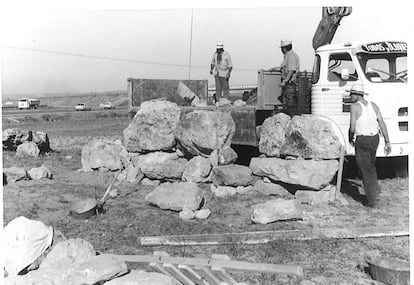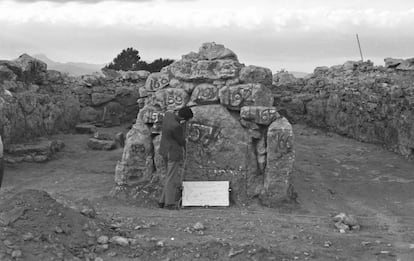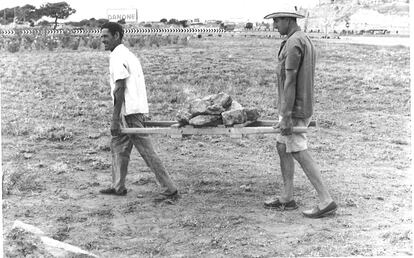The airport that crash-landed on a prehistoric ceremonial site in Palma
Five decades have passed since a huge Talaiotic archeological find was swept aside to make way for an airport runway on the Balearic Island of Mallorca

At the start of the 20th century, the remains of 100 buildings belonging to the great prehistoric ceremonial site of Son Oms in the capital of the Balearic Island of Mallorca, Palma, were still in evidence, including a sanctuary, three tower-shaped constructions called talaiots, a 25-meter ancient burial mound known as a tumulus with steps and circular corridors, a man-made cave, a necropolis and a labyrinth.
In 1964, only 10 of these were still apparent; and in 1971, they were reduced to the one remaining piece of evidence from an ancient civilization that archaeologists were able to save: the sanctuary.
In the 4th century BC, a Talaiotic community, belonging to a culture that developed in the Balearic Islands some 3,000 years ago, settled in what is now the municipality of Palma
Five decades have now passed since the destruction of the impressive Talaiotic site of Son Oms, which was declared a national monument in 1963. Its crime? It happened to be “trespassing” on the location earmarked for a runway for the Son Sant Joan airport. Despite the scientific community’s objections, no mercy was shown, as historian Domingo C. Hernández Jiménez points out in a report titled The Son Oms archaeological site, an example of the destruction of national heritage, published in the journal ArtyHum.
In the 4th century BC, a Talaiotic community, belonging to a culture that developed in the Balearic Islands some 3,000 years ago, settled in what is now the municipality of Palma. They built a settlement known as Som Oms Vell and, just one kilometer away, a large ceremonial complex known as Som Oms. Such was the size of the complex that it survived intact until Roman times. However, during the Middle Ages, agriculture and the demand for large blocks of stone reduced the complex to a quarry, though the remains of its enormous structures were still visible until the beginning of the 20th century.
The Som Oms site was chosen back in the 4th century BC because it stood on the banks of a lagoon that allowed the community access to the Mediterranean but which dried up between the 19th and 20th centuries. Some years later, between 1959 and 1964, the site was excavated by archaeologists Guillem Rosselló Bordoy and Lluís Pericot i Garcia, with the Joan March Foundation funding the work. On April 25, 1963, it was declared an Historic-Artistic Monument, affording it the highest possible level of protection on a par with a Gothic cathedral or Roman aqueduct.

But in 1969, a decision was made to expand the nearby airport. The archaeologists proposed a different location, but to no avail. The complex was razed.
The runway obliterated the tumulus and also a 19-meter building with different three heights, known as the labyrinth due to its configuration, three talaiots – two circular and one square – and at least one necropolis for the burial of children.
The tumulus consisted of a stepped building of about 25 meters in diameter, with three tiers and four radial rooms attached to an interior circuit. It also contained a zigzag corridor. In front of its entrance was a courtyard with a well that led to a deep man-made cave with chambers. Burials were discovered in every corner and would have been carried out between the 4th and 2nd centuries BC. According to what archaeologist Roselló Bordoy wrote, “it would have had a magical or ritual function, losing its main role as a place for worshipping the dead over time.”
The burials found inside the tumulus corresponded to adult burials that were accompanied by grave goods. Eight corpses were found in the access tunnel and five in the antechamber, of which three were found without grave goods, in a kneeling position but lying on their left side and covered with earth and large stones, according to Hernández Jiménez. In the first chamber, there was also a ninth body lying on its back and surrounded by pottery with either a spearhead or arrowhead by its hand.

The archaeologists discovered that three of the bodies were not buried at death, but there is some doubt whether they died of violent or natural causes – possibly due to some kind of epidemic. About 250 meters from these bodies, a necropolis of infant burials was excavated, with the tiny corpses kept in stone vessels. Roman and Balearic pottery was also unearthed, as well as awls and spatulas, mixed with loom weights and hand mills, all of which were transferred to the Museum of Mallorca.
Given the imminent destruction of the complex, the archaeologists only had time to excavate a quarter of its surface. “We do not have all the information that could have helped to fully clarify its function and use,” says Hernández Jiménez. “We tried to proceed to a second stage of excavation and preservation, by transferring everything to another location, but it was impossible. We gave up due to the weight of the stones and because many, when trying to transport them, cracked or broke. The only thing that could be done was to change the location of the sanctuary [that now lies between the various airport access highways]. The rest disappeared forever along with other archaeological elements, due to the institutional neglect on behalf of both the state and local administrations.”

The salvaged sanctuary is a rectangular building with an irregular layout. It has a double wall, with an exterior made from large sandstone blocks, a main façade measuring 11.9 meters and six columns in its interior. Its function was religious – a place of worship and sacrifice. According to the archaeologists carrying out the excavation, the lower level corresponded to the Roman-indigenous period and the middle level corresponded to around 50 AD, which is when it was abandoned, although it was used again in the 2nd century AD.
Inside, the remains of pottery from the Roman period were found, adorned with graffiti. They are Balearic ceramic pieces, with a chronology that places them between 50 BC and 50 AD. The graffiti corresponds to two Roman gods, Jupiter and Mercury. According to historian María José Pena, who compiled Hernández’s research, “the association of Jupiter and Mercury in the same sanctuary seems to lead us to Italic and/or Celtic environments, not indigenous or properly Roman.”
“Mercilessly destroyed”
The talaiot, on the other hand, was circular, with a corridor at its entrance and a central column, with four adjoining rooms. According to Catalina Cantarellas, one of the archaeologists who excavated Son Oms in the 1960s, “everything was mercilessly destroyed. There were many internal complaints, but nobody listened to us. In the end, as an empty gesture, some soldiers arrived with metal detectors to see if they could find any metallic element to salvage. They said they found nothing. I don’t think the detectors worked. It was very sad.”
Hernández Jiménez adds that it is unfortunate that the complex can no longer be visited in its entirety. “Given its importance, an attempt was made to have the second runway project modified,” he says. “But despite its status as a Historic-Artistic Monument, its fate was sealed due to a total lack of interest from the local and national authorities.”
English version by Heather Galloway.
Tu suscripción se está usando en otro dispositivo
¿Quieres añadir otro usuario a tu suscripción?
Si continúas leyendo en este dispositivo, no se podrá leer en el otro.
FlechaTu suscripción se está usando en otro dispositivo y solo puedes acceder a EL PAÍS desde un dispositivo a la vez.
Si quieres compartir tu cuenta, cambia tu suscripción a la modalidad Premium, así podrás añadir otro usuario. Cada uno accederá con su propia cuenta de email, lo que os permitirá personalizar vuestra experiencia en EL PAÍS.
¿Tienes una suscripción de empresa? Accede aquí para contratar más cuentas.
En el caso de no saber quién está usando tu cuenta, te recomendamos cambiar tu contraseña aquí.
Si decides continuar compartiendo tu cuenta, este mensaje se mostrará en tu dispositivo y en el de la otra persona que está usando tu cuenta de forma indefinida, afectando a tu experiencia de lectura. Puedes consultar aquí los términos y condiciones de la suscripción digital.
More information
Últimas noticias
Most viewed
- Sinaloa Cartel war is taking its toll on Los Chapitos
- Oona Chaplin: ‘I told James Cameron that I was living in a treehouse and starting a permaculture project with a friend’
- Reinhard Genzel, Nobel laureate in physics: ‘One-minute videos will never give you the truth’
- Why the price of coffee has skyrocketed: from Brazilian plantations to specialty coffee houses
- Silver prices are going crazy: This is what’s fueling the rally









































